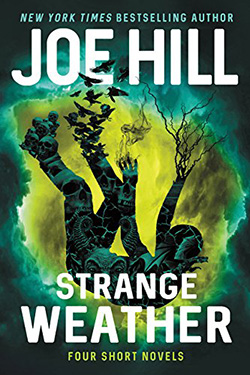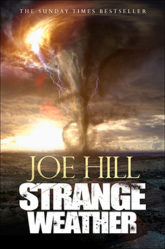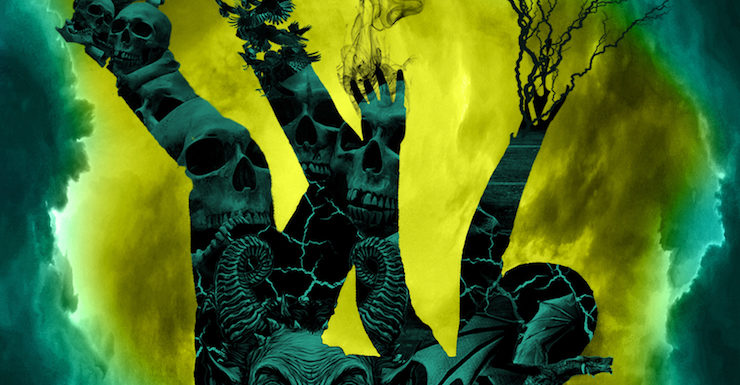“After writing a couple seven-hundred-page novels back-to-back,” Joe Hill has it in the afterword to his electric new collection, “it felt particularly important to get lean and mean,” and Strange Weather is exactly that: it’s not long, and damn it, it’s nasty.
A striking selection of novellas ranging from the playfully apocalyptic to the wickedly political, Strange Weather starts with an actual flash in “Snapshot,” the unsettling story of a boy who crosses paths with a man in possession of a magical camera. This old Polaroid captures more than just those Kodak moments, of course: it captures the very memories of those moments, in sum leaving its subjects with holes in their souls.
Michael Figlione is just a kid when “Snapshot” begins, so when he sees his old babysitter Shelly Beukes walking around the street they share, barefoot and swearing, he assumes she’s simply senile. As a decent human being he does the decent thing and takes her home to her husband, who gives Michael ten bucks for his trouble. It’s only when he goes to the local truck stop to spend his earnings and sees a creepy guy pointing a camera like a pistol that Shelly’s seemingly insane story—about a man who’s been stealing her essential self, picture by painful picture—starts to make sense.
Gripped by this suspicion, Michael stands guard over a sleeping Shelly later that same day, determined to catch the so-called Polaroid Man in the act. And he does, ultimately. But the story doesn’t end there… though I rather wish it had. Economical in its narrative and affecting in its Stranger Things-esque setting, the first half of “Snapshot” is stunningly done; sadly, the second section struck me as superfluous: slow and unfocused except insofar as it speaks to the themes at the centre of Strange Weather.
There is, to be sure, some seriously weird weather in this collection: between the storm that rages on as Michael confronts Shelly’s tormentor in “Snapshot,” the cyclonic blaze that looks likely to raze the town where the next tale takes place, the custardy cumulus the lovelorn protagonist of “Aloft” lands on and the razor-sharp rain that gives Strange Weather‘s final fiction its name, the pathetic fallacy is in full effect in all four stories. But in terms of connective tissue, another, markedly more meaningful motif pervades these pieces: the struggle to let go of what we’ve lost.
Buy the Book


Strange Weather: Four Short Novels
What Shelly has lost is obvious; what Michael loses, less so. George Kellaway, the accidental hero at the heart of “Loaded”—a straight story suggestive of the Sandy Hook Elementary School shooting in December of 2012—has lost his family. The restraining order his wife has taken out against him means he’s also had to sacrifice his right to bear arms. But he still has a gun, by gum! A gun he’s horribly happy to use when a woman who’s been abused by her boss opens fire in the middle of the mall where Kellaway works.
Bodies promptly drop, including those of a Muslim woman and the bundled-up baby Kellaway mistook for a bomb—not to mention the only other witness to the incident. That guy gets one in the head as well, because otherwise, Kellaway would be in a whole bunch of trouble. As is, he has a good story to tell the first proper responders; a tale as tall as time that leads people to believe he saved the day instead of devastating it.
Celebrated as a hero by the media-savvy mayor, Kellaway is soon sitting for interviews, and starting to hope that not only will he get away with multiple murder, perhaps he’ll even get his family back. But as the irregularities in his account start to surface, things take a terrible turn. “Kellaway felt like a bullet in a gun himself, felt charged and ready to go off, to fly towards some final, forceful impact. Loaded with the potential to blow a hole in what everyone thought they knew about him.” He does just that in a conclusion so unbearably brutal that it chills me still.
It’s a shock to the system when Strange Weather’s darkest story segues into its slightest and lightest, “Aloft,” which follows a fellow on his first skydive. He isn’t your everyday daredevil, however. “Aubrey has always been scared of heights. It was a good question, why a man with a dread of heights, a man who avoided flying whenever he could, would agree to jump from an airplane. The answer, of course, was maddeningly simple: Harriet.”
Harriet is “the girl [Aubrey] wanted as he’d never wanted anyone else,” and as the dismaying details of the pair’s relationship to date are doled out, readers will realise that “Aloft” is their story. Their story just so happens to be wrapped around a particularly peculiar premise. You see, Aubrey doesn’t make landfall with the love of his unlucky life. Instead, his dive terminates early when he loses his parachute on a semi-solid cloud that looks and feels like it’s made of “acre after acre of mashed potato.” Stranded on this desert island of sorts, he must to come to terms with his feelings for Harriet, and her feelings for him, if he’s to have any hope of touching terra firma again.
That “Aloft” is the most whimsical of Strange Weather’s four stories is fitting, considering it was written in the back of a notebook containing the finale of The Fireman basically because Hill hated “to see so much paper go to waste.” But, as the author himself explains, it was “Rain,” the collection’s closer, that “arose from a desire to spoof myself and my own sprawling end of the world novel.”
 “Rain” really is rather a lot of fun, particularly as it pertains to the White House’s comments on the catastrophic change in climate that results in a hail of nails:
“Rain” really is rather a lot of fun, particularly as it pertains to the White House’s comments on the catastrophic change in climate that results in a hail of nails:
The operating theory—lacking any other credible explanation—was terrorism. The president had disappeared to a secure location but had responded with the full force of his Twitter account. He posted: “OUR ENEMIES DON’T KNOW WHAT THEY STARTED! PAYBACK IS A BITCH!!! #DENVER #COLORADO #AMERICA!!” The vice president had promised to pray as hard as he could for the survivors and the dead; he pledged to stay on his knees all day and all night long. It was reassuring to know that our national leaders were using all the resources at their disposal to help the desperate: social media and Jesus.
It’s a testament to Hill’s not insignificant abilities that even here, in the midst of this rather ridiculous apocalypse, there remains resonance. Its protagonist, one Honeysuckle Speck, is haunted by the loss of her sweetheart, who was one of the first to fall victim to the disastrous downpour. Unable to accept Yolanda’s death, she determines to deliver the news to her other half’s father, which means navigating a stretch of highway that showcases the slippery grip civilisation has on society. Turns out all it takes to cause a collapse is—snap!—some strange weather.
I found the conclusion of “Rain” is a touch too tidy; similarly, “Snapshot” suffers from this occasional proclivity of Hill’s, this inclination to offer answers to unasked questions. It’s telling that “Aloft” and “Loaded” are Strange Weather‘s strongest stories: their ambiguous endings allow them to live past their last pages. That one is wacky and wonderful while the other’s twisted tragedy proves all too easy to believe evidences the tremendous diversity of this collection. If NOS4A2 and The Fireman were Hill’s ’Salem’s Lot and The Stand, then this, dear readers, is his Different Seasons: a demonstration of his range and readiness to tell the hell out of any tale, be it supernatural or straight, silly or completely serious.
Strange Weather is available October 24th in the US from William Morrow and publishes November 7th in the UK with Gollancz.
Niall Alexander is an extra-curricular English teacher who reads and writes about all things weird and wonderful for The Speculative Scotsman, Strange Horizons, and Tor.com. He lives with about a bazillion books, his better half and a certain sleekit wee beastie in the central belt of bonnie Scotland.










